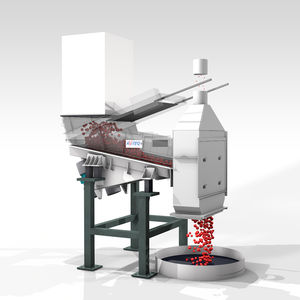
- Packing - Handling - Logistics
- Conveying
- Vibrating conveyor
- AViTEQ Vibrationstechnik GmbH
Vibrating conveyor troughtransportfeeder
Add to favorites
Compare this product
Characteristics
- Technology
- vibrating
- Form
- trough
- Function
- transport, feeder
- Construction
- enclosed
- Transported product
- for bulk materials
- Sector
- for the food industry
- Other characteristics
- stainless steel, long-distance
Description
AViTEQ- vibrating feeder are suitable for conveying and dosing the majority of bulk material's. Vibratory feeders are capable of conveying a wide range of particle sizes. Designed to be robust, either of an open or enclosed trough design. The trough-shaped structure are particularly suitable conveyors in extreme environmental conditions, because of the easy cleaning ability, but also suitable in the chemical and food industry.
Advantages & benefits of vibrating feeders
Wide range of applications:
• using magnetic vibrator drive(s) or electro mechanical vibrator(s)
• dust-proof versions available (enclosed)
• long conveying possible using multiple connected vibratory feeders
• multiple drives possible
• manufactured in mild steel or stainless steel
Construction
Vibrating feeders are characterized by their simple design. The main components are:
• feeder with drive traverse
• drive
• in-/outlet pipe (covered variants)
• elastic support elements
• flexible seals
Selection
The vibrating feeder sizing is dependent on:
• bulk material
• throughput
• required geometry
• possible installation mass
Key figures
• length: up to 9,000 mm on single units, theoretically unlimited for conveyor lines
• width: up to 3,500 mm
• throughput: up to 1,000 m³/h
• drive: magnetic vibrator, unbalanced motor, exciter
Catalogs
No catalogs are available for this product.
See all of AViTEQ Vibrationstechnik GmbH‘s catalogsOther AViTEQ Vibrationstechnik GmbH products
Conveying technology
Related Searches
- Rail conveyor
- Transporting conveyor
- Horizontal rail conveyor
- Conveyor for the food industry
- Feeder
- Vibration motor
- Stainless steel conveyor
- Materials handling conveyor
- Automatic dosing unit
- Bulk products conveyor
- Solid dispensing system
- Dosing unit for the food industry
- Loading and unloading system
- Feeding conveyor
- Conveyor for the pharmaceutical industry
- High-precision dispensing system
- Vertical rail conveyor
- Vibrating feeder
- Part conveyor
- Compact conveyor
*Prices are pre-tax. They exclude delivery charges and customs duties and do not include additional charges for installation or activation options. Prices are indicative only and may vary by country, with changes to the cost of raw materials and exchange rates.












